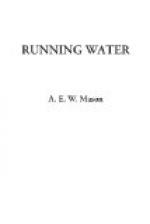“There’s one of the difficulties disposed of,” he said, cheerily. “You did very well, Wallie—very well. It was not altogether nice, was it? But you won’t have to go back.”
Walter Hine had indeed crossed the glacier without complaint. There had been times when he had shivered, times when his heart within him had swelled with a longing to cry out, “Let us go back!” But he had not dared. He had been steadied across the narrow bridge with the rope, hauled up the ice-walls and let down again on the other side. But he had come through. He took some pride in the exploit as he gazed back from the top of the snow-slope across the tumult of ice to the rocks on which he had slipped. He had come through safely, and he was encouraged to go on.
“We won’t stop here, I think,” said Garratt Skinner. They had already halted upon the glacier for a second breakfast. The sun was getting hot upon the slopes above, and small showers of snow and crusts of ice were beginning to shoot down the gullies of the buttress at the base of which they stood. “We will have a third breakfast when we are out of range.” He called to Delouvain who was examining the face of the rock-buttress up which they must ascend to its crest and said: “It looks as if we should do well to work out to the right I think.”
The rocks were difficult, but their difficulty was not fully appreciated by Walter Hine. Nor did he understand the danger. There were gullies in which new snow lay in a thin crust over hard ice. He noticed that in those gullies the steps were cut deep into the ice below, that Garratt Skinner bade him not loiter, and that Pierre Delouvain in front made himself fast and drew in the rope with a particular care when it came to his turn to move. But he did not know that all that surface snow might peel off in a moment, and swish down the cliffs, sweeping the party from their feet. There were rounded rocks and slabs with no hold for hand or foot but roughness, roughness in the surface, and here and there a wrinkle. But the guide went first, as often as not pushed up by Garratt Skinner, and Walter Hine, like many another inefficient man before him, came up, like a bundle, on the rope afterward. Thus they climbed for three hours more. Walter Hine, nursed by gradually lengthening expeditions, was not as yet tired. Moreover the exhilaration of the air, and excitement, helped to keep fatigue aloof. They rested just below the crest of the ridge and took another meal.
“Eat often and little. That’s the golden rule,” said Garratt Skinner. “No brandy, Wallie. Keep that in your flask!”
Pierre Delouvain, however, followed a practice not unknown amongst Chamonix guides.
“Absinthe is good on the mountains,” said he.
When they rose, the order of going was changed. Pierre Delouvain, who had led all the morning, now went last, and Garratt Skinner led. He led quickly and with great judgment or knowledge—Pierre Delouvain at the end of the rope wondered whether it was judgment or knowledge—and suddenly Walter Hine found himself standing on the crest with Garratt Skinner, and looking down the other side upon a glacier far below, which flows from the Mur de la Cote on the summit ridge of Mont Blanc into the Brenva glacier.




